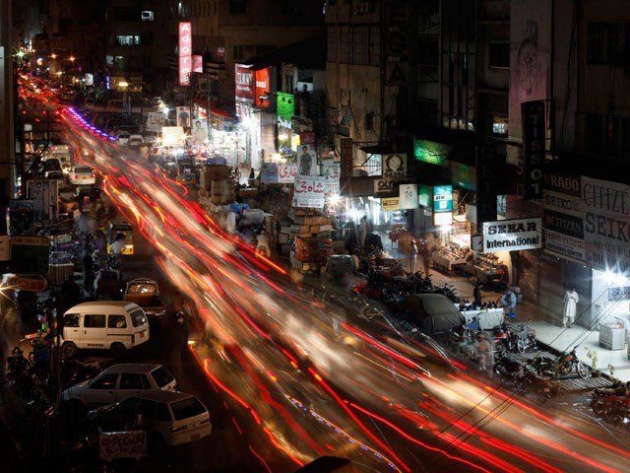
I find it rather problematic to fashion a semblance of a concrete structure from the conundrum that is Karachi’s metropolis. The metropolis I speak of comprises not of sky-scrapers and high-rise buildings that brush against the clouds and billboards lit with neon lights. On the contrary, the metropolis that harbours the heart of Pakistan lives and breathes, just like you and I.
She breathes with the quivering, ragged gasps of an invalid. She inhales mouthfuls of air contaminated by generations of ignorance and growing dissent, and punctuated by the overpowering stench of rotting human remains. The city that once stood as the jewel in the crown of a nascent country – a beacon of hope, of growth, of a united mass of young men and women dissolving the divisions of ethnicity, caste, and creed for the purpose of striving towards building the foundations of a nation – now gazes at the smog filled sky in despair, watches the blurry outlines of the setting sun sink into the blue sea and braces herself for showers of bullets and rivers of blood.
This piece shall be based upon patterns of identity and discourse within Karachi, how these patterns have evolved over the course of the past few years with respect to Karachi’s rapidly burgeoning and vastly diverse demographic and why, amidst clouds of chaos and escalating civil strife, Karachiites find themselves struggling to identify themselves as citizens of a nation of 180 million individuals.
For the sake of simplicity, I shall broadly divide this troubled city not along a geographical context but along the lines of the paths and rifts that have been erected betwixt the city’s burgeoning populace. Mohammad Waseem, in his working paper for the Saban Centre at Brookings titled Patterns of Conflict in Pakistan: Implications for Policy, states that,
“Every fifth household in Pakistan, every fourth in Punjab and Sindh provinces, and more than half in Karachi are ‘migrant’.”
By ‘migrant’, Waseem is referring to the Urdu-speaking migrants or the mohajirs from North India that settled primarily in Karachi following Partition. The other half of Karachi’s demographic comprises of a lethal cocktail: a mixture of four different ethnicities, a rallying cry against suppression at the hands of a dominant majority, a far cry from the cosmopolitan melting-pot of cultures and faiths that Karachi once was.
An article published by the New York Times in November 2010 for instance, very blatantly claimed that Karachi was Pakistan’s “most deadly place” after its actual war zones. But, the threat Karachi faces is starkly different from the Taliban insurgency being battled by the Pakistani army up north. On the contrary, the article claimed,
“Far more common [in Karachi] have been killing by gangs affiliated with ethnic-based political parties hunting for turf in a city undergoing seismic demographic change.”
Three years forward, Karachi’s woes have not dissipated.
In a recent press conference, the leader of a Pakhtun political party claimed that leaders of his party were receiving death threats and that “extremist elements” were still operative within Karachi’s Pakhtun-dominated areas.
Karachi is a city that struggles to thrive and survive amidst barbed wires and makeshift battlefields littered with shoes and stones and streaks of blood. But, why do Karachiites seem acquiescent of the fact that Karachi will, for time and memoriam, be divided along the lines of cast and ethnicity?
I answer this pressing matter of concern via research that I based upon the aim of unearthing the state of mind of the average citizen of Karachi in order to understand and comprehend the divisions that exist betwixt a sample size of eight Karachiites and how these divisions translate to ethno-political rivalries in a larger sphere. My sample size comprised of affluent members of society between the ages of eighteen and twenty one. The reasons behind choosing this particular sample size are two-fold: Karachi’s affluent civil society is a) devoid of the passionate class-based ethnic rivalry that exists amongst members of Karachi’s working classes and is more likely to look upon Karachi’s growing instability and political strife with an objective view and B) responsible for the mass political movement that sprung up before the 2013 General Elections and was geared towards alleviating Karachi from the stronghold demagogic influences.
Karachiites struggle to identify themselves as citizens because the problems that plague them on a daily basis are several steps away from those that the rest of Pakistan faces. My sample size unanimously agreed upon a focal factor responsible for Karachi’s woe: Politicisation of the masses, from university based student unions to workers unions to politicised police and law enforcement agencies. The desire for self-fulfilment overpowers the need to recognise and work towards the greater good of society.
But what makes Karachi significantly different?
The overwhelming difference between the proportions of people involved directly into politics and the common citizenry that is influenced into pledging allegiance. In order to reinforce my claim, I spoke to Chambeli*, a Hindu resident of Karachi’s Shireen Jinnah Colony, who very vociferously claimed that political workers showed up during Diwali and Holi festivities close to elections in order to win hearts and minds and votes. And although every five years, members of predominant parties have promised and pledged to provide water and sanitation to members of the locality, their words are always in vain. Most of Chambelis’ family and friends have stopped exercising their right to vote because they claim that political workers “can speak but can’t act upon their words”.
I shall close this article not with a fervent repetition of what has been said time and time again, but with a journey. Bus M4 travels from Hyderi to North Nazimabad to Gurumandir to Shahra-e-Faisal’s wide boulevard to Defence’s repertoire of bungalows and neat picket fences and perfectly manicured gardens. It stops at rickety excuses for bus stands, weaving through honking cars and bumper-to-bumper traffic, picks-up the maid that toils away in House 23/A each day, the factory worker, the clerk, the young student with the unkempt hair and the furrowed brow, the mochi with calloused fingers and clothes that smell faintly of leather, the mother whose laden with groceries bought from Sabzi Mandi and carries a young child in the crook of her arm, the poet lost in thoughts that float back to a time of idyll and peace and harmony. The bus stops at its final destination and the passengers disembark – the maid, the factory worker, the student, the mochi, the mother and her child, the poet – and turn their frenzied eyes towards the horizon. In the backdrop of the setting sun casting rays of gold across the clear sky, they assimilate with the masses. They let their feet sink into the soft sand as the roaring waves crash against their forms and they sway, only to be held firmly by those behind them. A binding, strengthening chain of humans. And in that moment, the disparities that threaten to overpower and separate Karachi into a million fragments fade away.
*Names have been changed to protect the identity of people interviewed.



